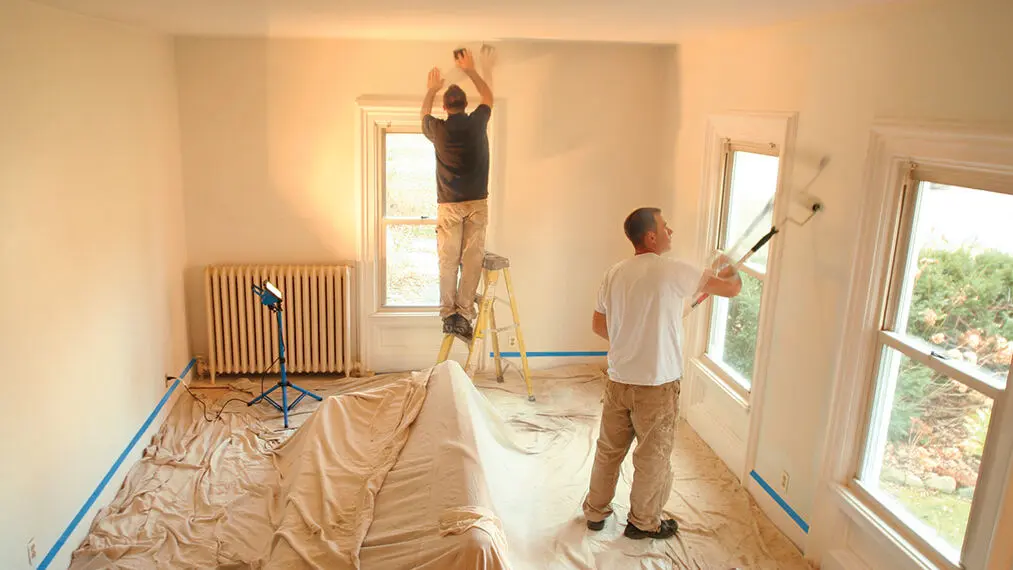How to Prep Your Home for a Professional Paint Job

Hiring a professional painter is one of the most effective ways to refresh your space, protect your investment, and add value to your property. But before the first drop of paint goes on the wall, the way your home is prepped can have a major impact on the outcome.
When you’re working with a trusted painting contractor, you’re not expected to handle the heavy lifting—that’s their job. But knowing how to prepare your house for professional painting makes it easier for the crew to do their work efficiently, safely, and with precision. From clearing clutter to communicating special concerns, a few simple steps ahead of time help ensure a smooth experience and lasting results.
In this post, we’ll break down how to prepare your house for professional painting—and why professional prep paired with your participation makes all the difference.
What to Expect From a Professional Prep Process
While homeowners can take simple steps like clearing furniture or discussing access, the bulk of prep work should be handled by professionals, and that’s where a quality contractor makes all the difference. A reliable painting company won’t just show up and start painting—they follow a detailed, proven process to prepare every surface with care.
Here’s what that typically includes:
- Thorough inspection and documentation of any damaged areas
- Pressure washing for exterior surfaces to remove dirt, mildew, and loose paint
- Sanding or scraping to smooth rough patches and flaking paint
- Repairing surface imperfections, such as cracks or holes in drywall or stucco
- Masking and covering of trim, windows, doors, and landscaping as needed
- Priming bare or previously uncoated areas to ensure even color and adhesion
This prep stage is where shortcuts can cause serious long-term issues. A well-prepped surface allows the paint to bond properly, resist peeling, and maintain its finish for years, not just months.
When choosing a painting contractor, don’t be afraid to ask about their prep process. A true professional will be transparent about each step and how it contributes to the durability of your finished result.
Clear the Space: Make Room for the Pros to Work
Before any paint cans are opened or ladders are set up, professionals need a clean, unobstructed workspace. One of the most helpful things homeowners can do is remove items that could slow down the process or risk getting damaged.
For interior painting, this usually means:
- Taking down artwork, mirrors, and wall-mounted items
- Clearing off shelves, counters, or mantels
- Relocating small furniture like side tables or lamps
- Pulling larger furniture (like sofas or beds) 3–4 feet away from the walls, if possible
Don’t worry about moving heavy pieces—that’s something your painting team can help manage. But reducing clutter ahead of time gives them a faster start and helps prevent accidents.
For exterior painting projects, it’s helpful to:
- Remove potted plants, garden décor, and patio furniture from areas near the walls
- Trim back bushes or shrubs that might block access to siding or trim
- Make sure pathways and driveways are clear for equipment and ladders
These simple steps allow the crew to set up safely and work efficiently—helping ensure your paint job stays on schedule and on budget.
Protect Surfaces You Want to Keep Paint-Free
Professional painters take pride in clean, crisp lines and neat workspaces. They’ll come prepared with drop cloths, painter’s tape, plastic sheeting, and other protective tools. But as a homeowner, you can help by identifying what needs extra care or coverage before the project begins.
Start by securing or relocating anything that may be vulnerable to paint splatter or dust:
- Electronics like TVs, desktop computers, and speakers should be unplugged and moved or covered.
- Window treatments such as curtains or blinds can be removed or tied back to give painters full access.
- Delicate light fixtures or hanging decor should be taken down in advance if they’re near the work area.
Outdoors, think about anything close to the exterior walls that could collect overspray or get in the way:
- Cover or move grills, outdoor lighting, or decorative statues
- Relocate bikes, storage bins, or children’s toys to a safe zone
While your painters will handle all necessary surface prep—from taping baseboards to covering floors—being proactive helps avoid confusion and protects the items that matter most to you. It also reinforces clear boundaries between what’s being painted and what stays untouched.
Communicate Special Instructions in Advance
A great paint job starts with clear communication. Before the first brushstroke, it’s important to let your painting team know about any special instructions, problem areas, or preferences that could affect the scope or timing of the work.
If you’ve noticed issues like:
- Water stains, cracked drywall, or previous paint failures
- Mildew spots in humid rooms like bathrooms or laundry areas
- Unusual textures or surfaces that might need extra prep
Also, clarify things like:
- Room access restrictions (e.g., home offices during working hours)
- Areas that require extra protection (such as built-ins, appliances, or pet zones)
- Paint color confirmations—especially if there are accent walls or custom blends
A reliable painting contractor will walk you through what to expect and confirm these details in advance. But the more specific you are about your needs, the more seamless the experience becomes, for both sides.
Plan for Access and Scheduling
Professional painters work best when they can move freely, stay on task, and complete their work without frequent interruptions. That’s why it’s important to plan ahead for how the crew will access your home and navigate your space during the project.
If you won’t be home during the day, make sure to:
- Arrange for access through a garage code, lockbox, or trusted neighbor
- Disable any alarm systems or notify your provider in advance
- Let the crew know your preferred contact method in case questions come up midday
For families with children or pets, a little planning goes a long way. Professional painters take safety seriously, but keeping little ones and animals out of active work zones is always a smart move. Consider:
- Designating a separate play area or quiet room during working hours
- Boarding pets or securing them in a non-work zone for interior jobs
- Avoiding exterior walkways and entry points that may be blocked or in use
With access and safety mapped out ahead of time, your painting team can stay focused on what they do best—delivering a beautiful, high-quality finish without delays.
A Little Prep Goes a Long Way
When you know how to prepare your house for professional painting, you’re not just making things easier for the crew—you’re also setting the stage for better results. A few thoughtful steps like clearing the workspace, protecting valuable surfaces, and communicating expectations can go a long way toward ensuring a smooth, efficient, and high-quality experience.
Professionals bring the tools, the skills, and the attention to detail. But your role in preparing the space helps them deliver the kind of work that lasts—and that you’ll be proud to show off.
Thinking about repainting your home? Start by speaking with a licensed, insured contractor who offers clear prep guidance, color consultations, and high-quality finishes.

